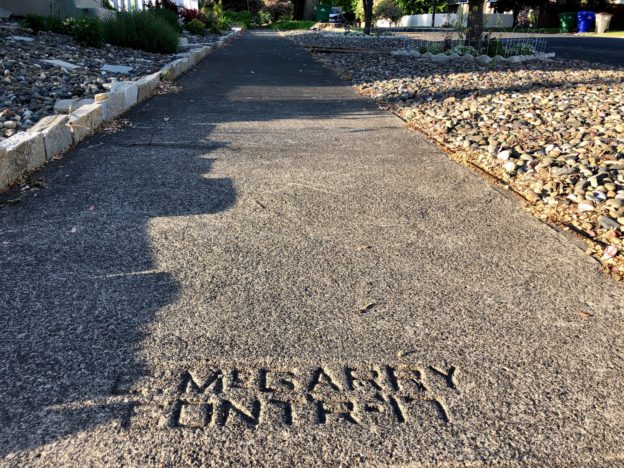by Don Kostelec
May 10, 2019
“E. McGARRY
CONSTR – ’17”
This sidewalk has been here, in Lewiston, Idaho, for 102 years.
Woodrow Wilson was President. Babe Ruth still played for the Boston Red Sox. Lewiston’s population was approaching 6,500. And E. McGarry Construction was leaving a mark on the city.
This sidewalk was built before zoning. It was built before traffic engineers even existed. It was built before state DOTs wielded great authority and influence over cities. It was built when motor vehicles were not the dominant mode of city transport.
There were 5.1 million motor vehicles registered in the United States that year. Lewiston was still five years away from having its first streetcar line.
Yet, in what many would argue was a less-enlightened era in urban transport, this sidewalk has features we struggle to obtain when new ones are built in 2019.
This sidewalk is 5 feet wide and separated from the roadway with a 12-foot wide buffer. That width and buffer provide enough space for two people to walk comfortably side by side.
It’s along a street wide enough for parking on both sides, which provides additional buffer from moving traffic despite it being on a low speed, low volume residential street.
This sidewalk has trees in the buffer to provide shade for the adjacent houses, the sidewalk, and the street. The average high temperature in Lewiston in July is 91 degrees.
It is not accessible to everyone in this city, however. It still lacks curb ramps at intersections because transportation resources have been devoted to widening roads for cars and replacing Lewiston’s old Spiral Highway with a new high-speed freeway.
It this sidewalk was along a major roadway, that buffer would provide greater safety from the threat of moving vehicles. A traffic engineer would probably tell you those trees are a safety threat to motorists. They would want the sidewalk next to the street to serve as a clear zone for errant motorists first, with it being a place for people to move as a secondary consideration.
A planner might struggle to require this in a current zoning ordinance. Trees could destroy the sidewalk. Developers don’t like giving up that much space. The traffic study didn’t say they were needed. The corridor study said we didn’t have enough right of way.
What else would you say about this sidewalk?

